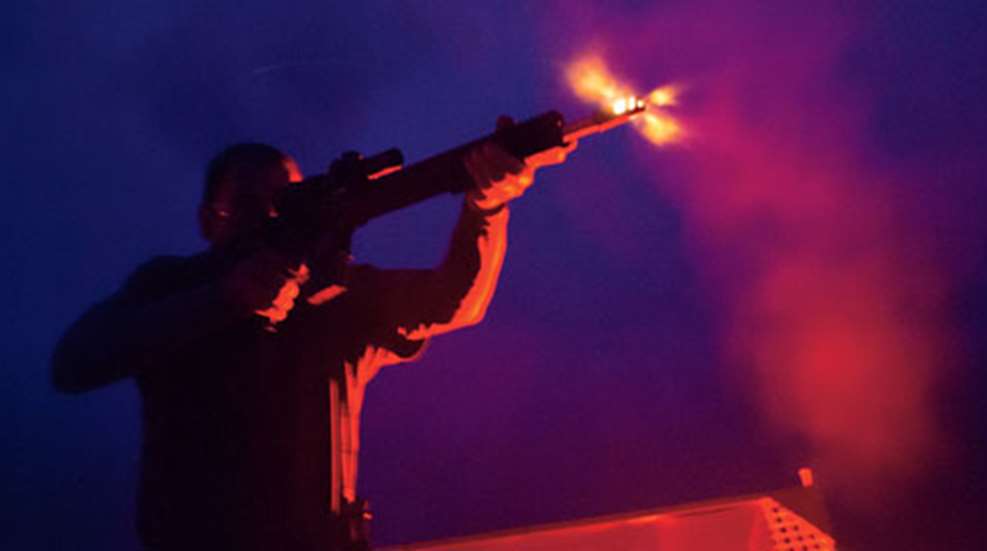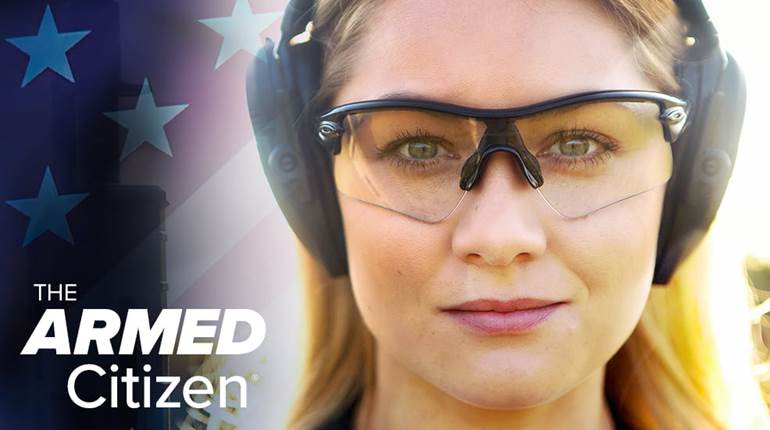
12/21/2012
I was on vacation with my family in Yellowstone National Park this year when I received an unexpected phone call. It was Iain Harrison with Crimson Trace Corp. You might have heard of him. He’s that popular guy with an accent who won the first season of the TV competition series “Top Shot.” He was calling to see if I would like to participate in the first Crimson Trace Midnight 3-Gun Invitational shooting match.
Sometimes the right answer to a good question is “yes,” and after a bit of schedule verification, that’s what I told Iain. I would be glad to take part in such a unique event. Not only did it have the earmarks of an exciting 3-gun match, but all of the shooting would take place at night with participants using lights and laser sights to work in low- and no-light scenarios. But my acceptance of the invitation did come with some trepidation. This was going to be my very first 3-gun match, and since I was new to the sport, I didn’t know exactly what I was getting into.
In hindsight, I can say with confidence that it was the right decision. I came away from my first 3-gun match having learned things I might not have learned any other way. But I also had to face and overcome many of the same obstacles and concerns that most people face when stepping into something they’ve never tried before. Here are a few of the things I learned by jumping feet first into a 3-gun competition.
Do Your Homework
Being new to a competitive sport is one thing, but walking onto the field guided by assumptions or incomplete information is another. A good place to start learning about 3-gun is the book The Complete Guide to 3-Gun Competition, by Chad Adams, a former American Rifleman staffer. This well-written guide provides a solid introduction to the sport. It clearly covers relevant topics including the history of the sport, the various divisions, popular firearms for 3-gun matches, general rules and regulations, and the support gear shooters often choose to use.
With that understanding, it was much easier to interpret the critical information contained in the Crimson Trace match-specific rules and the descriptions of each stage of the competition. For example, most long-range shots used staged guns provided at the match, while most of the rounds fired using our own guns took place at close range to accommodate the limitations of gun-mounted flashlights. All of that knowledge played a role in deciding what gear to gather and take.
Test Your Gear
With only a few weeks to prepare, I turned to the brands of guns and gear with which I was most familiar. My pistol was a Gen 3 Glock G34 tricked out with Crusader Weaponry’s Edge package of enhanced controls and surface treatment, Trijicon HD sights and a Viridian X5L green laser/light module. The rifle was a Windham Weaponry CDI AR-15 in 5.56x45 mm NATO (.223 Rem.) with a Leupold VX-R Patrol scope, XS Sights’ XTI Angle-Mount AR-15 sight system and a Crimson Trace MVF-515 fore-grip. The shotgun consisted of a 12-gauge Mossberg 930 SPX Tactical semi-automatic with a Streamlight TLR-1 mounted to the barrel. I used Winchester ammunition in all of the guns. Brownells was an ideal one-stop shopping resource for shotgun Picatinny light mounts, range bags and items such as shotshell belt caddies.
Was this the “perfect” gear set? Probably not for everyone, but it was a promising set for me. One thing 3-gun gurus warn against is running out and buying all of your gear at once. This can be a costly mistake as shooters find out that what they paid for is not the best fit for their personal needs. Start with what you already have on hand, borrow some of what you don’t have, then watch or participate in a few matches before you lay down any cash. Folks competing in these matches are usually happy to talk with beginners about their gun and gear selections. Once the initial gear set is available, head to the range to practice. The best way to reduce malfunctions is to run the guns in the configuration, and with the ammunition, you’re planning to use in the match.
Embrace The Malfunctions
When it comes to something going wrong in the course of a 3-gun match, it’s not a matter of if, but a matter of when. One of the blessings (from a training standpoint) and curses (from a scoring standpoint) of live-fire competition is the statistically higher possibility of equipment failure. Running three guns instead of just one triples the likelihood of a jam. Adding lights, lasers and optics into the mix creates even more opportunities for something to shake loose or fall off.
On top of possible gear failures is the added stress of competition, which leads to shooter-induced malfunctions. Experienced 3-gunners say that the competition nerves never go away. All of the time spent practicing on a static shooting range seems to suddenly evaporate when the buzzer sounds and the adrenaline begins to flow. Rounds are pumped downrange while moving, reloading and activating lasers and lights. All the while, the shooter’s progress is being carefully monitored by a group of peers, adding to the pressure.
So how can malfunctions and stress under these circumstances possibly be a blessing? Because problems, mechanical and mental, encountered in the course of a stage demand the development of shooting skills. Going to a match is the perfect opportunity to practice remaining calm and focused when the butterflies in the stomach start to swarm. It was very informative to watch how others dealt with those challenges. When one competitor’s gun-mounted light winked out, he instantly replaced it with a hand-held light from his belt. Some competitors, when they bogged down during a particular stage, would stop shooting that portion and move on to the next one so as to preserve more of their score and avoid timing out. Accidentally dropped magazines were smoothly replaced by fresh ones. One shooter had a feeding issue with his rifle, so he manually cycled each shot into the chamber using the charging handle to successfully complete the stage.
Improvisation, compensation, course correction and seemingly miraculous innovation all came into play as competitors tackled the obstacles that cropped up. While problem solving and a focused resolve to succeed are useful in generating positive marks on the score card, what the competition experience translates into is far more important. While most of us will thankfully avoid ever having to use deadly force in defense of our lives, when such situations arise they’re rarely easy to deal with. Adrenaline will surge, complex tasks may have to be completed on the move and defensive tools may malfunction. Live-fire training, and shooting competitions such as 3-gun, provide an opportunity to learn how to run defensive equipment under pressure.
By the way, this match brought defensive drills into, well, a whole new light. Most shooting practice takes place during the day or on well-lit ranges, but defensive situations tend to occur in low- and no-light environments. It was an eye-opening experience to see what lasers and lights can and can’t do. For example, lasers make fast target acquisition easy, but they don’t replace proper grip, stance and trigger control. Likewise, a pistol-mounted light will successfully illuminate a target, but hand-held lights can be safely pointed at anything in the area. In short, if you plan to use a light or laser with your defensive firearm, include these devices in your regular practice regimen.
Be Safe
There just isn’t room for unsafe gun handling practices in any of the competitive shooting sports, but especially in 3-gun. Not only are the shooters in motion, but they are exchanging firearms as they’re moving. With the added factors of working late at night and in occasionally stormy conditions, competitors at the Crimson Trace match took safety very seriously.
The number one DQ (disqualification) that will instantly result in someone getting booted off the range and out of the match is a violation of “The 180.” Each stage is usually designed so that a shooter will fire to the front or each side of his body, which creates an imaginary 180-degree arc from his left to right. If the shooter violates the arc by pointing his muzzle behind himself, even a little, he is done for the day, or in this case, for the night. We were urged to slow down and pay close attention to our muzzle control. Participants asked plenty of questions about each course of fire to ensure they didn’t violate the 180-degree rule, or any of the other important safety regulations. If there was any confusion about the course of fire, they sought clarification rather than take any risks.
Join In
If I had to sum up my initial concerns about going to a 3-gun event for the first time, it was that I didn’t want to look bad in public. Reading and hearing about all of the A-grade, nationally ranked competitors who would be in attendance didn’t help. “Great,” I thought, “I’m going to look like the only guy playing a tuba on a stage full of rock stars.”
But then a couple of bits of sage advice, offered by a few different friends, provided a positive reality check. First, no one wins their first match—no one. In fact, it can take years of competition to move up the ranks. It’s unrealistic to expect to place high, let alone win, on the very first outing into such a technical and challenging type of competition. Secondly, I was told that 3-gun matches draw a diverse set of shooters, which means a wide range of skill and experience levels will be present on the field. Along with the shooting stars who compete for a living, there were plenty of hobbyists and first-time competitors to mingle with.
Best of all, the competition was held in a spirit of fun and good sportsmanship. The up-beat tone was certainly fostered by the Crimson Trace staff, but that seems to be indicative of the 3-gun community as well. The participants were there to enjoy themselves, to make new friends and to have a great time shooting. Crimson Trace put on a world-class event, and like everyone else I talked to, I hope to get invited again next year. If you see an opportunity to participate in a 3-gun match sometime soon, then don’t hesitate to jump right in. Conduct some research into the sport, focus on staying safe, and go ahead and enjoy some of the most fun and instructive shooting available.




































